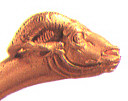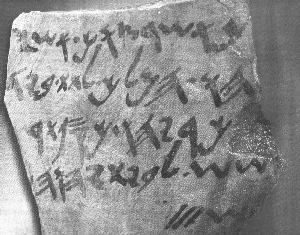
site map
Golden Fleece > paleo Hebrew script
craftsman's art and music's measure
for thy pleasure all combine.
paleo Hebrew script
the writing system of King Solomon's Temple
About 3,000 years ago paleo Hebrew script replaced cuneiform as the main writing system. Many examples of this script have been found in and around Jerusalem from the centuries before the destruction of King Solomon's Temple.


This ostracon, or inscribed potsherd contains the oldest complete extra Biblical mention of the House (or Temple) of Yahweh (LBYT YHWH) ever found. On this ostracon (dated to the ninth to seventh century B.C.), no word divider or dot separates LBYT and YHWH. The phrase unmistakably means "House (or Temple) of Yahweh." This translation strengthens the reading of BYT DWD on the Tel Dan inscription, which also lacks a word divider, as "House of David." This ostracon thus supports the understanding of the Tel Dan inscription as the first extra Biblical mention of King David." - Biblical Archaeology Review, Nov./Dec. 1997, Vol. 23, No. 6, p. 30 (p. 28-32)
About 2,500 years ago, Ezra supervised the transcription of the ancient writings into Hebrew script and it was in this form that generations of Jewish scribes faithfully copied and preserved the ancient scriptures for two thousand years as the Massoretic text.
Martin Luther freely consulted Jewish rabbis during the translation of the Hebrew scriptures based on the Massoretic text as published by Gerson Ben Mosheh at Brescia in 1494. Luther's copy of the Hebrew scripture was preserved in the Royal Library at Berlin. This great project brought together princes, scholars and craftsmen to produce elegant, printed Bibles in many languages. The thirst for knowlege of the Hebrew language developed an understanding and appreciaton of Jewish traditions, which lead to greater respect for Jewish communities.
Copyright © 2001-2009 The Fleece. All rights reserved.